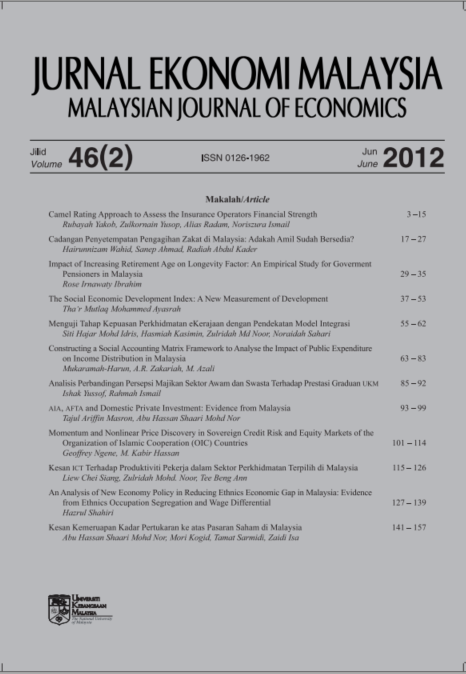Jurnal Ekonomi Malaysia
46 (2) 2012 63 – 83
Faculty of Economics and Management
Universiti Putra Malaysia
43400 UPM Serdang Selangor
MALAYSIA
Abstract
The use of the social accounting matrix (SAM) in income distribution analysis is a method recommended by economists. However, until now, there have only been a few SAM developed in Malaysia. The last SAM produced for Malaysia was developed in 1984 based upon data from 1970 and has not been updated since this time despite the significance changes in the structure of the Malaysian economy. The paper proposes a new Malaysian SAM framework to analyse public expenditure impact on income distribution in Malaysia.The SAM developed in the present paper is based on more recent data, providing an up-to date and coherent picture of the complexity of the Malaysian economy.The paper describes the structure of the SAM framework with a detailed aggregation and disaggregation of accounts related to public expenditure and income distribution issues. In the SAM utilized in the present study, the detailed framework of the different components of public expenditure in the production sectors and household groups is essential in the analysis of the different effects of the various public expenditure programmes on the incomes of households among different groups. The SAM utilized in the present study can be applied to answer questions concerning whether components of public expenditure expansion would benefit the poor and, if so, which components are most likely to be beneficial. Other accounts are in aggregate form, such as the accounts for companies, accounts for private capital investment, and accounts for the Rest of the World (ROW). When evaluating public sector expenditure impacts on income distribution, most economists use a variety of policy tools including econometric models, cost-effectiveness analysis and social cost benefit analysis. These existing tools rely on estimation procedures that do not account for the complex interactions between poverty; income distribution; the endogeneity of the income distributions; and other variables. The strength of the SAM utilized in the present study over the tools mentioned above lies in the consistency of the modelling of the distribution of income and its ability to trace out chains of linkages from changes in demand to changes in production, factor incomes, household incomes and final demands.
Keywords
Similar Articles
- Isu Agihan Pendapatan di Malaysia: Penilaian Melalui Pendekatan Islam Hadhari
- Who Gain and Lose from the Minimum Wage Policy?
- The Effect of Tourism Expenditure on the Economy: A New Evidence
Bibliography
@article{Harun2012Constructing,
title={Constructing a Social Accounting Matrix Framework to Analyse the Impact of Public Expenditure on Income Distribution in Malaysia},
author={Harun, Mukaramah and Zakariyah, A.R and Mohamed, Azali},
journal={Jurnal Ekonomi Malaysia},
volume={46},
number={2},
pages={63—83},
}
Receive updates when new articles are published.


